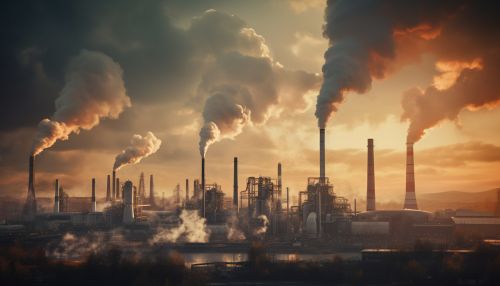Greenhouse Gas
Introduction
Greenhouse gases (GHGs) are gaseous constituents of the atmosphere, both natural and anthropogenic, that absorb and emit radiation at specific wavelengths within the spectrum of thermal infrared radiation emitted by the Earth’s surface, the atmosphere itself, and by clouds. This property causes the greenhouse effect. Water vapor (H2O), carbon dioxide (CO2), nitrous oxide (N2O), methane (CH4), and ozone (O3) are the primary greenhouse gases in the Earth's atmosphere. Moreover, there are a number of entirely human-made greenhouse gases in the atmosphere, such as the halocarbons and other chlorine and bromine containing substances, dealt with under the Montreal Protocol. Besides CO2, N2O and CH4, the Kyoto Protocol deals with the greenhouse gases sulfur hexafluoride (SF6), hydrofluorocarbons (HFCs), and perfluorocarbons (PFCs).


Physical Properties
The physical properties of greenhouse gases include their ability to absorb heat in the atmosphere, their concentration, and their residence time, or lifetime, in the atmosphere. The effectiveness of a greenhouse gas is determined by its absorption properties, which can vary with the wavelength of radiation, the temperature, and the pressure. The concentration of a greenhouse gas in the atmosphere determines how much of the gas is available to absorb radiation. The residence time of a greenhouse gas refers to the average time a molecule of the gas remains in the atmosphere before it is removed by natural processes. These properties determine the overall warming potential of a greenhouse gas.
Sources and Sinks
Greenhouse gases are emitted by both natural processes and human activities. Natural sources include decomposition, ocean release, and respiration. Human sources include the burning of fossil fuels, deforestation, industrial processes, and some agricultural practices. Sinks, or reservoirs, include the oceans, the biosphere, and the lithosphere, which can absorb these gases and store them for varying lengths of time.
Impact on Climate Change
Greenhouse gases play a critical role in the development of climate change. The increase in concentrations of these gases in the atmosphere enhances the greenhouse effect, which is the warming that happens when the atmosphere traps heat radiating from Earth toward space. Certain gases in the Earth's atmosphere block heat from escaping. Long-lived gases, which remain semi-permanently in the atmosphere and do not respond physically or chemically to changes in temperature, are described as forcing climate change. Gases, such as water vapor, which respond physically or chemically to changes in temperature, are seen as feedbacks.
Mitigation Strategies
Mitigation strategies for greenhouse gases focus on reducing emissions and increasing the capacity of carbon sinks. Strategies include using energy more efficiently, switching to cleaner fuels, preserving and planting forests, and developing new technologies. International agreements, such as the Paris Agreement, have also been established to limit and reduce emissions.
